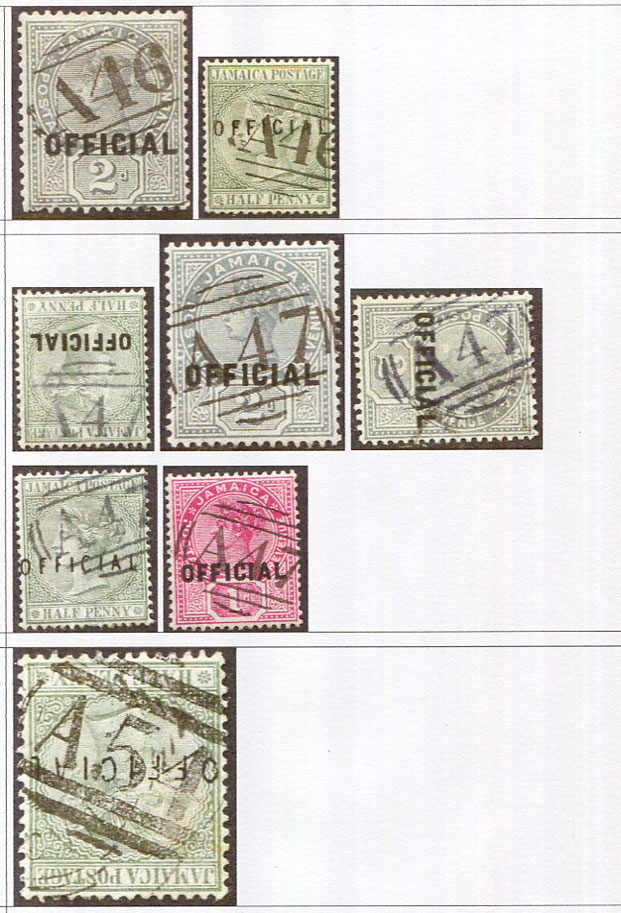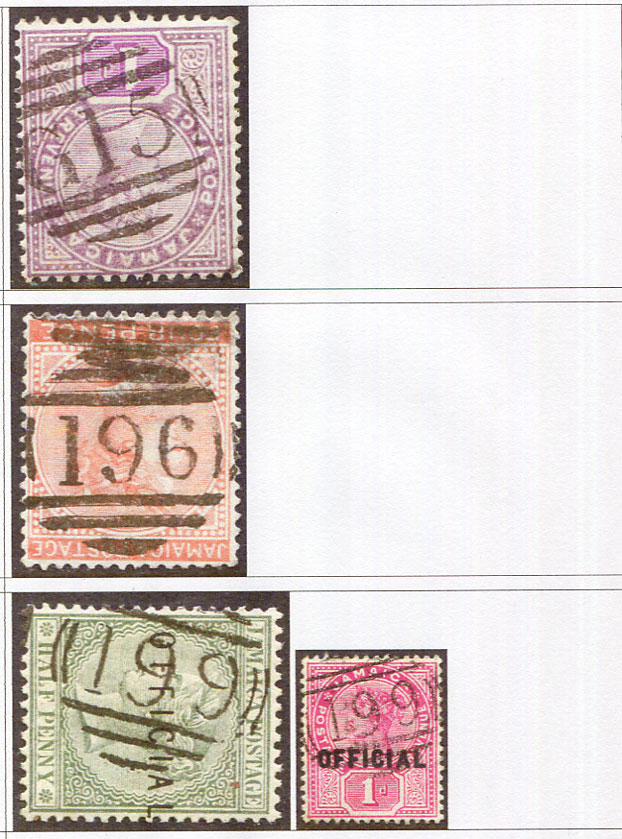See "BUY THE BEST" for records of postmarks, scans of covers with text, provenance, maintained over 45 years. BUY YOUR OWN DIGITAL PDF FILE ................... Knowledge puts you ahead in the game
| Country: Jamaica Clear Subject: All | Sort: Newest listed first |
My current count for the different combinations of obliterators on QV Pine, CC, CA wmks, QV Keyplates, QV Falls, QV Fiscals, and 1903 Badge issues is 1,916 items. Although I am not a collector I have my own form of collection in that I now have 1,602 scanned combinations, and 314 missing for completion. These counts do not include Kingston Head Office “A01” but only cover the town cancels “A27” through to “E”. Included are coloured inks (only blue,and violet) and the two manuscript numbers of “36” and “37” and the possible “A67” on QV 1/- CC Ex Duffus. Bisects are not included as they mainly come on complete cover. In mentioning coloured inks I have seen two examples red “A01” supplied to John Buckner, Florida in the 1980’s. Most elusive, for me, are those which fall on the 1903 Arms issues as I do not have a single scan. Lucky is the collector I sold a wonderful Arms cover cancelled by one of the oblits. many years back. Ideally 106 pages can be allocated for these 1,916 combinations so that all “A27” fall on one page, and blue inks, or manuscripts, have their own pages. Probably the most diverse range are those for Cold Spring “193” - no examples are known on Pine wmks so far (the office opened end September 1874) but extremely rare examples of the QV 2/- (SG.14) and QV 6d orange (SG.23) have been found used at this office. Some offices give me quite a shock when I look at my pages. Probably the worst is Richmond “A79”(J) where I find I have 9 scans and 14 missing scans to complete the page. Added to these 106 pages are pages set up to show examples of the FALMOUTH cds (P11); MILE GULLY cds (P9) SAVANNA-LA-MAR manuscript “X” overstruck “A01”, SAVANNA-LA-MAR cds (P11); brass “½” on QV 2d Pine possibly used Spanish Town; manuscript assisted “A67” used Port Royal; the newly discovered manuscript Manchioneal dated by Kingston cds A/JY 29 76 which all contribute to the obliterator story. Double and Inverted surcharges have been included in the count.

(Updated 26 May 2020) The illustrated JAN 31 1910 and JUN 2 1911 strikes are different. The 1910 has closely set ‘IC' and wider ‘M’ in JAMAICA. The Maltese crosses may be different in format; and whilst the JAMAICA GOV’T. RAILWAY in the 1910 strike has apostrophe and stop in ‘GOV’T.’ the 1911 may differ in it not having the stop. If you can supply decent full strikes for this period please do so. David Horry has very kindly supplied drawings of the two cancellations (subject clarification on the GOVT portion in the 1911 strike), and an overlay of the two cancels to show their difference.

(2 May 2020) LCC Nicholson in 1949 mentions the A80 (K) with larger figures and suggests it may have been sent out earlier than the A80 (K) with smaller figures known employed at Mount Charles with later name changed to Hagly Gap. The reality is that the A80 (K) larger figures obliterator has proved so elusive that even the Charles Winand collection (of 1531 different combinations with stamp/numeral on Pine wmk to Keyplates “A27” to “E”) contained not a single example, and Winand himself confused, even tried to separate his five examples A80 (K) small into smaller and larger versions of the same instrument! Confusion is further extended in the Proud handbook with the A80 small shown as a Type H horiz. obliterator. There is no evidence linking A80 (K) large to Mount Charles or elsewhere due there being no covers or dated pieces.

(29 April 2020) Collecting made-to-order needs of the moment unusual instructive handstamps must be fun and quite challenging. This Jamaica cover with Hotel Titchfield flag-flying flap to San Antonio, Texas travelled uncancelled until it reached Pasadena, California on MR 9 1912 and the postmaster felt obliged to tell the eventual recipient that his cover was trapped inside a circular during transit. A nice item to include in an Arms display. The Anguilla Valley postmaster, in 1996, before any actual transit to Basseterre, has gone to extraordinary length with a mind-boggling message that the sender’s letter is certified to have been received in good condition at his post office! Bad condition yes, but good condition?


(Updated 27 April 2020 thanks to emails from Ed Barrow and Mike Kitson) It is becoming clear that not only the stamps of Great Britain were used at their postal agencies abroad but a more formal arrangement existed covering mail arrangements to and from those territories in the Caribbean basin. Early Jamaica QV stamps exist pmk’d “C51” (St. Thomas), “D60” and red “D63” (whereabouts unknown), “E88” (Colon) and one 1876 ingoing cover shows a spectacular Cuba 50c, Great Britain 4d. and Jamaica 2d combination.

(25 April 2020) Mail which has travelled across the Atlantic and cannot be delivered is found with “Unclaimed”, “Deceased”, “Left the Island” etc handstamps or manuscript endorsements and assumed to be returned to sender, when known, free of further charge. Mail which has crossed “both ways” falls into two groups. Unpaid mail, as a result of the Act of 1847 made it compulsory for the sender to pay postage on returned unpaid letters, and short-lived handstamps surmounted by a Crown and inscribed “The Party to whom this letter/is addressed has not Called for it/(date)" were applied at London, Edinburgh, or Dublin. The second group is prepaid additional postage adhesive mail, with illustrations from Barbados (JU 9 1860), and Trinidad (MR 8 1864).




High priced postmarks on catalogued stamps will always attract the forger and it is no surprise that forged cancels exist in all shapes and sizes on GB used abroad stamps. Those wishing to benefit financially from their endeavours have cleaned manuscript cancelled REVENUE issues and applied forged cancels to make them look postally used. Apart from those two groups the village cancels for all of the British West Indies remain largely unscathed (and virus free!). If you look to Bermuda numerals on QV issues you will be hard pressed to find any forgeries as no catalogue value was ever applied to them. Bob Topaz, in the USA, however produced his rarity chart for Jamaica numerals back in 1967, and in 1981 added £ sterling premiums to all the known combinations. Some of the rarest of the Topaz combinations may not exist at all unless in forgery/fake form as one keen individual took a fancy to forging Jamaica numerals on what would appear to be almost exclusively OFFICIAL issues, many with bluish ink tinge. Whether this was a result of the Topaz pricing, or whether they were prepared to be included in the counts supplied by collectors to Topaz we will never know. I stumbled across these as they appeared in bulk in a Jamaica numeral collection auctioned in the UK which I recognised as belonging to an American collector with initials ABN, possibly a totally innocent party. Around about the same time, perhaps earlier or later, I purchased the Charles Winand collection of Jamaica numerals and noted that a few forgeries from the same stable had found their way onto his album pages. The fakes from the two collections were eventually merged and set aside, and now are presented for the first time. If genuine the group would have been worth a small fortune as most are listed as rare, very rare, extremely rare. For the time being these are held safe, and the illustrations now provided should help to act as a safeguard to collectors in the future.









The collecting of cancellations showing full extended village name and full date has always been an attractive proposition, but numeral strikes less so. Bob Topaz, in the USA, completely changed that situation when he contacted all fellow collectors of Jamaica and asked for a complete breakdown of all their numeral cancels on Pine wmk, Crown CC, Crown CA, QV keyplates etc. Armed with all the replies he established a chart which he published in 1967 showing their scarcity and allocated ER (extremely rare) down to C (common) for all the combinations. Later, in 1981, he completed his project by added £ sterling prices being the premium for fine strikes on top of catalogue value of the actual stamp. Blank spaces in his chart indicated that the obliterator had not been noted and "Topaz unrecorded" was always, and still is, a joy to find. Charles Winand of the UK probably amassed the finest collection of all known combinations but even he with all all years of collecting failed to acquire a single copy of the large vertical "A80" oblit, and not having ever seen one his album page of small vertical "A80" oblits were separated as either small or large if they looked just slightly different! Bozo Ivanovic acquired the Winand collection and kept it intact for many years adding new additions to a stock book rather than mounting them on the Winand pages. Bozo, in turn, sold me the complete collection. Before breaking it up I felt that it should be recorded for posterity and used to illustrate every known combination. Mike Rego prepared the template page for me, and with the help of Paul Hancock, also living in Dorset, scans of all strikes known to us were placed in each square and stepped up in quality when better strikes turned up. Photocopies of the Winand album pages were taken but have never been released. Blank squares show stamps not yet acquired and those squares with "Not Seen" are still Topaz unrecorded. Over 2,000 combinations of numeral/stamp are possible!

The attached article was written for the British West Indies Study Circle journal and appeared in the June 2015 issue. John Tingey has his article on this cover scheduled for the August 2015 edition of "Stamp & Coin Mart" written in the form of an Arthur Conan Doyle "whodunnit" (should go on sale approx. 12th July).




My understanding is that this was printed by De La Rue on yellowish-white paper with overlay in bluish-grey. The 6d stamp depicting Priestman's River is printed in purple (shades). There are three settings. First, which includes forms overprinted SPECIMEN in black, has no dot between Y and T of ANYTHING and no dot before E of ENCLOSED in the 3-line warning. The second setting has the dot between Y and T only, and the third setting has both the dot between Y and T and the dot before E. The third setting was used from mid-1950 until 1954. The attached scans are both third setting form, one MISSING PRIESTMAN'S RIVER STAMP IN PURPLE COLOUR. The form has typewritten commercial letter from E. F. Aguilar to Muscotts dated Nov. 12, 1951. Tom Foster in his Jamaica Newsletter No. 15 explains that Aguilar was in the habit of dealing with much of his philatelic correspondence at the Kingston G.P.O. during his lunch hour. On one ocassion, having forgotten his notebook, a postal clerk gave him a wad of blank Air Letter forms which merely bore a blank square in place of a stamp. Many were used as note-paper for personal and business correspondence, often written in pencil, before it was realised they were ERROR forms. What is not explained is what happened next! Were the forms allowed to be removed from the G.P.O. Does anyone have error forms with pencil notes on them, have other typewritten, but not posted, error forms survived? Are there error forms from the third setting mailed with actual adhesive? Sightings and comments appreciated.






